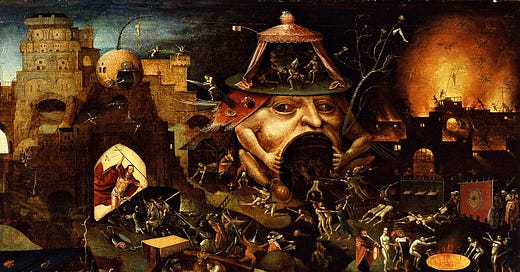We All Live in the Firestorm: Infinite Crisis and the LA Wildfires
Jathan Sadowski on the ecological, financial, social, and political crises threatening to swallow us whole.
This guest post is from Jathan Sadowski, with whom I co-host our podcast This Machine Kills. Jathan's fantastic second book ("The Mechanic and the Luddite: A Ruthless Criticism of Technology and Capitalism") just came out!
His book offers a ruthless criticism of capitalist technological innovation, as well as some ideas about the Luddism that has informed our analysis for years now. I’ll be speaking with him about it on January 30th at City Lights in San Francisco at 7:00 PM PST (with fellow Luddite Brian Merchant!)
In one of the most destructive wildfires to ever hit Los Angeles, more than 12,000 structures and 35,000 acres have burned across two major blazes in the Palisades and Eaton areas, with other smaller but still large fires popping up. As the firestorm jumped the Pacific Coast Highway into densely populated suburbs of Santa Monica, a city in West LA, entire neighborhoods were turned into ash. A video taken late Wednesday night in the front seat of a car driving down the PCH from Palisades to Malibu shows rows of buildings engulfed in flames as hurricane-force winds spread the embers further. “It’s like driving through hell,” remarks the cameraperson.
The hellish scene in LA is a tragedy, but importantly it is not an isolated or independent event. A problem only for the many people in the evacuation zones. We must see this most recent crisis as one more node added to a global network of ongoing crises, each one resulting in different forms of mutually reinforced devastation, but all of them interconnected, with their consequences touching everybody, everywhere. We all live inside the firestorm now.
We have to see how the crisis and its impacts in LA are directly linked to, among other things, hurricanes in Florida, floods in Queensland, turbulence in the insurance industry, instability of mortgage markets, growing insecurity in society, and policies that have hollowed out government services and abandoned entire communities.
Consider how the firestorm is emblematic of systemic crises: ecological, financial, social, political.
Climate change is not merely a danger reserved for other people who are removed from us in space and time. We are seeing its immediate, material impacts right now. A warming world has created conditions that are ripe for disaster. Seasonal winds and wildfires are nothing new for California but their frequency and severity has intensified in recent decades.
Research supported by the US National Oceanic and Atmospheric Administration shows that anthropogenic climate change has been the “main driver of this increase in fire weather in the western United States.” Warmer air holds more moisture leading to more rain which nurtures the growth of plant life. But when that rain is then followed by prolonged droughts and arid winds all that vegetation dehydrates, turning into kindling ready to burst into flames and embers. The increased fuel combined with fierce winds act as an accelerant for firestorms.
While we call them natural disasters, there is nothing natural about their level of destruction. Despite the known risks of building houses in places like Malibu or Miami, real estate capital continues pouring into high-risk areas without comparable investment into risk mitigation strategies to make buildings and communities more resilient to fires and floods. At the same time, austerity measures in the name of government efficiency have gutted essential services. In a case of terrible timing, last month LA Mayor Karen Bass cut the LA Fire Department’s budget, despite warnings that it would hamstring their ability to respond to large-scale emergencies.
All these social and political factors mean that when catastrophe inevitably hits, the personal and financial losses are far more significant. The most recent estimates from AccuWeather place the total damage and economic loss of the LA wildfires at $250 billion—and potentially the costliest disaster in US history.
This financial disaster is caused and compounded by upheaval in insurance markets and rampant under-insurance for climate risks. In response to large-scale wreckage caused by catastrophes like fire, flood, and hurricanes, property insurers are raising premiums to record highs and rejecting policies for markets deemed exclusion zones. Despite popular narratives framing insurers as victims on the brink of collapse, insurers benefit from “hard markets” that allow them to dump high-risk, low-profit policies and agitate for regulatory change.
Meanwhile, communities who rarely had to think about their risk profiles—and largely do not understand their actual risks or coverage for catastrophes—are now confronted with the grim reality of being uninsurable. Even if they were fortunate to not lose everything this time, next time they may not be so lucky. And the safety net they once relied upon will be even more threadbare and full of holes.
With every new disaster that strikes, insurance policies become less available, less affordable, and less adequate for the growing numbers of people who need more protection in the face of more risks. “There may be more than $1 trillion in hidden home-value losses from floods and fires alone, writes Bloomberg columnist Mark Gongloff, “posing the threat of a mini financial crisis.”
Indeed, a report last month by the US Senate Budget Committee warns of a “climate change-driven insurance crisis” based on new data about increased insurance non-renewals that shows “a crash in property values may be looming.” We can see further omens of a crash in mortgage markets as Fannie Mae and Freddie Mac fill their portfolios with perilous levels of climate risk from fires and floods, while government regulators disregard the threats of unsustainable risk-taking.
There are similar shocks occurring in markets in the aptly named FIRE sector—finance, insurance, and real estate—around the world. For example, a new report by the Australian Actuaries Institute shows that due to surging insurance costs nearly 200,000 households across Australia have either breached their mortgage contracts, or are at extreme risk of doing so, because they cannot afford to maintain insurance policies.
The systemic crises threatening the stability of these crucial markets—which are the foundation for so much wealth and security in modern society—continue to multiply and interface. It’s hard not to hear the distinct echo of the 2008 financial crash. The causes are different but the dynamics rhyme.
Our exploration of interconnected crises could keep expanding outward. A core feature of these many crises is that they don’t have the kinds of clear boundaries and direct causes that are conducive to simple framings of a problem and its solution. Our social world is much more complex.
Any effective strategy for mitigating the risks of such catastrophes—and responding to their aftermath—requires seriously confronting this network of crises. Or, what many now recognize as the age of polycrisis: a system in which seemingly “disparate shocks interact so that the whole is worse than the sum of the parts,” writes Adam Tooze.
The problem with polycrisis is that it defies any single fix—as if kicking sand on the smoldering coals in front of you will stop the inferno once and for all. But so far this has largely been our collective reaction to each individual crisis as they pop off, all while largely ignoring their networked nature and the systemic solutions they demand.
Unless we can read the signs and contain the spread of polycrisis, the LA firestorm will be yet another harbinger of more crises to come—until we are flanked on all sides by disasters with no clear escape route.





Jathan, how can we avert the tragic cycle of investor 'catastrophe shopping'? As insurers price original homeowners of the LA, Altadena, and Pasadena properties right out of home ownership, investors move in, turning these neighborhoods into prefab rental nightmares. Not sure of the Greater LA housing ordinances, but in many parts of the country, placing a trailer on your property (instead of a home) allows owners to keep their land whilst avoiding exorbitant property taxes, insurance, etc., buying time for victims of disaster to get back on their feet.
Is time of the essence here? How do we signal our CA legislators, urging them not to give into the insurance company demands, leaving millions of people dispossessed. If what you said is true in the TMK podcast, the insurers have already made more than enough bank on investing our premium dollars—and now it's time for the insurance industry to hold up their end of the bargain.
Quite a good post and without a doubt the major arguments are on point. One thing I must, as an Angeleno, point out. There really is no "Eaton area" in greater LA. The Eaton Fire was named so because it started in the Eaton Canyon, but if we're referring to broader towns and/or residential areas, we're talking about Altadena/Pasadena in this case. The Palisades Fire was named that because it started in Pacific Palisades, but naming conventions for wildfires aren't exactly consistent. Also, this isn't the only commentary to make this specific mistake (assuming there's a town there because that's what it's named). I'm aware it sounds pedantic. I suppose I only point it out because, as Jathan points out, we're probably all going to be hearing a lot more about these fires going forward.